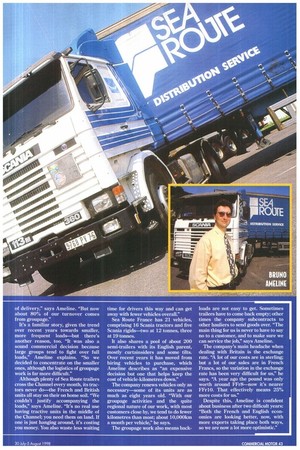'RENCHMAN DAVID KALFON set up Sea Route in 1968 expressly
Page 44

Page 45

If you've noticed an error in this article please click here to report it so we can fix it.
to serve the cross-Channel haulage market from a base in Eastleigh, Hants. It used to co-operate with a French partner, then took it over and renamed itself Sea Route France in 1979.
The company is involved in general haulage, much of it chemical and petrochemical products. "It's about 80% cross-Channel work because that is what we have done since our origins," says Sea Route France director Bruno Ameline. The other 20% comes from domestic transport and other operations, among them a rail transport service to Italy which creates work for about 30 trailers a week.
Although the destination hasn't changed much over the years, the nature of the loads has. "We started off transporting full loads only, which mean the advantage of a single point of delivery," says Ameline. "But now about 80% of our turnover comes from groupage."
It's a familiar story, given the trend over recent years towards smaller, more frequent loads—but there's another reason, too. "It was also a sound commercial decision because large groups tend to fight over full loads," Ameline explains. "So we decided to concentrate on the smaller ones, although the logistics of groupage work is far more difficult."
Although plenty of Sea Route trailers cross the Channel every month, its tractors never do—the French and British units all stay on their on home soil. "We couldn't justify accompanying the loads," says Ameline. "It's no real use having tractive units in the middle of the Channel; you need them on land. If one is just hanging around, it's costing you money. You also waste less waiting time for drivers this way and can get away with fewer vehicles overall."
Sea Route France has 21 vehicles, comprising 16 Scania tractors and five Scania rigids—two at 12 tonnes, three at 19 tonnes.
It also shares a pool of about 200 semi-trailers with its English parent, mostly curtainsiders and some tilts. Over recent years it has moved from hiring vehicles to purchase, which Ameline describes as "an expensive decision but one that helps keep the cost of vehicle-kilometres down."
The company renews vehicles only as necessary—some of its units are as much as eight years old. "With our groupage activities and the quite regional nature of our work, with most customers close by, we tend to do fewer kilometres than most; about 10,000km a month per vehicle," he says.
The groupage work also means back loads are not easy to get. Sometimes trailers have to come back empty; other times the company subcontracts to other hauliers to send goods over. "The main thing for us is never to have to say no to a customer, and to make sure we can service the job," says Ameline.
The company's main headache when dealing with Britain is the exchange rate. "A lot of our costs are in sterling; but a lot of our sales are in French Francs, so the variation in the exchange rate has been very difficult for us," he says. "A year ago the pound was only worth around FFr8—now it's nearer FFr10. That effectively means 25% more costs for us."
Despite this, Ameline is confident about business after two difficult years: "Both the French and English economies are looking better, now, with more exports taking place both ways, so we are now a lot more optimistic."












































































































